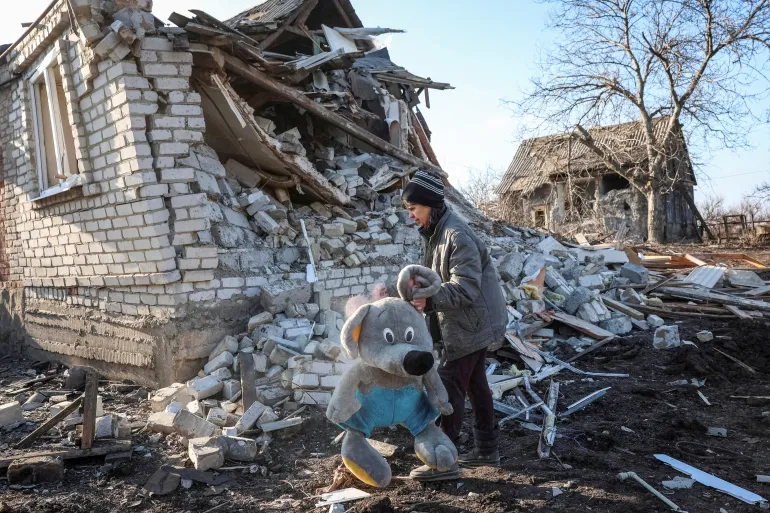As Russia’s full-scale invasion of Ukraine enters its 1,086th day, the conflict continues to escalate with intense fighting, diplomatic maneuvering, and high-stakes geopolitical ramifications. Here are the latest developments as of Friday, February 14.
The battlefront remains volatile as Russia’s Defence Ministry announced the capture of Vodyane Druhe, a settlement in the Donetsk region. The seizure marks another step in Moscow’s persistent push to consolidate its control over eastern Ukraine, despite fierce resistance from Kyiv’s forces.
Meanwhile, Russia claimed to have launched a coordinated overnight assault targeting Ukrainian military airfields, drone production workshops, ports, and fuel storage sites. The attack was part of a broader strategy to disrupt Ukraine’s military logistics and weaken its defensive capabilities.
Ukraine responded with an aggressive counteroffensive, reportedly launching a massive wave of drones and missiles. Moscow stated that its air defense systems intercepted 202 unmanned aerial vehicles, three French-made Hammer guided bombs, and U.S.-supplied HIMARS rockets. The scale of Ukraine’s attack underscores its resilience and continued reliance on Western-supplied weaponry.
Ukraine’s Security Service confirmed that one of its drone strikes successfully hit Russia’s Andreapol oil pumping station, causing a significant oil leak and fire, according to Reuters. The strike represents Ukraine’s ongoing strategy of targeting critical Russian infrastructure to weaken Moscow’s war efforts.
In a separate development, Russia launched 140 drones in an overnight assault, according to the DPA news agency. Ukrainian forces managed to intercept 85 of them, while more than 50 reportedly failed to reach their intended targets. However, damage and casualties were reported in Ukraine’s Kharkiv and Odesa regions.
Ukrainian military commander Oleksandr Syrskii stated that Ukrainian forces currently control approximately 500 square kilometers (193 square miles) of Russia’s western Kursk region. This marks a reduction from the 800 square kilometers (309 square miles) Kyiv controlled in September, highlighting the shifting dynamics of territorial control.
The conflict also took a deadly turn in eastern Ukraine, where a Russian strike on Kramatorsk in Donetsk claimed the life of a 46-year-old man and injured five others, including a 16-year-old girl. Another attack in Kherson reportedly killed two more civilians, aged 58 and 62, further illustrating the war’s devastating toll on non-combatants.
Amidst the ongoing hostilities, high-level diplomatic discussions are intensifying. Kremlin spokesperson Dmitry Peskov stated that a meeting between U.S. President Donald Trump and Russian President Vladimir Putin must be arranged “promptly.” Moscow aims to engage Washington in discussions over European security, signaling potential shifts in diplomatic engagements.

However, Ukraine’s Foreign Minister Andrii Sybiha, in an interview with Le Monde, warned against excluding Kyiv and Europe from any future negotiations between Trump and Putin. Ukrainian President Volodymyr Zelenskyy reinforced this stance, declaring that Ukraine would not accept any agreements regarding its future made solely by Washington and Moscow. He insisted that a comprehensive plan to “stop Putin” must be implemented before any peace talks can proceed.
Zelenskyy also urged world leaders to be cautious of Putin’s overtures, warning against premature trust in the Russian leader’s claims of a willingness to negotiate an end to the war.
Meanwhile, European Union foreign affairs chief Kaja Kallas emphasized that any backdoor deal on Ukraine’s future would be doomed to fail. In a related development, Moldova’s Foreign Ministry summoned Russia’s ambassador after two Russian drones exploded within Moldovan territory, highlighting the war’s spillover risks.
The International Committee of the Red Cross (ICRC) reported a staggering increase in the number of missing persons due to the war. Over the past year, documented cases of missing individuals have more than doubled to 50,000. According to the ICRC, 90 percent of these missing individuals are military personnel.
NATO Secretary-General Mark Rutte stated that the alliance must ensure that Putin “never attacks Ukraine again.” However, he clarified that Ukraine had never been explicitly promised NATO membership as part of any potential peace agreement, addressing speculations regarding Kyiv’s future alignment with the military bloc.
In a significant diplomatic offer, Reuters reported that the United Arab Emirates has extended an invitation to host peace talks between Russia and Ukraine. This development introduces another potential venue for conflict resolution, though the feasibility of such discussions remains uncertain given the current tensions.
As the war rages on, global powers are positioning themselves for a potential resolution—one that could reshape Europe’s security landscape. The coming weeks will be critical in determining whether diplomacy can gain traction or if the conflict will further escalate.
Stay updated with the latest developments on global affairs, technology, business, and leadership at Innovation Times. Sign up now to receive exclusive insights and expert analysis straight to your inbox.
Stay ahead with the latest news on global innovation, leadership, entrepreneurship, business, and tech. Join us on WhatsApp or Telegram for real-time updates. Have a report or article? Send it to report@theinnovationtimes.com.
Follow us on X (Twitter), Instagram, LinkedIn, Pinterest and Facebook for more insights and trends



